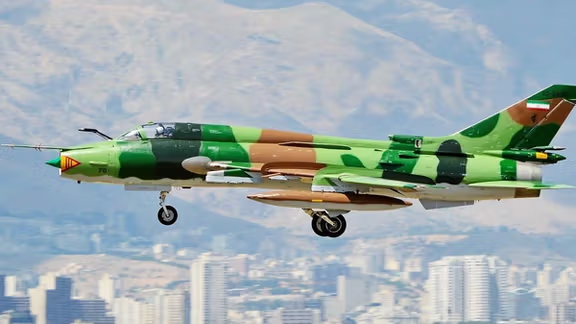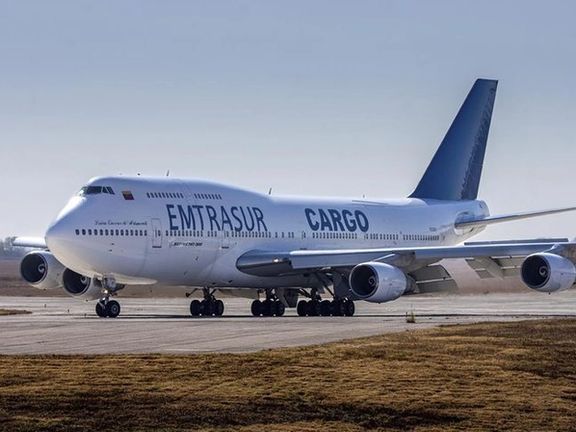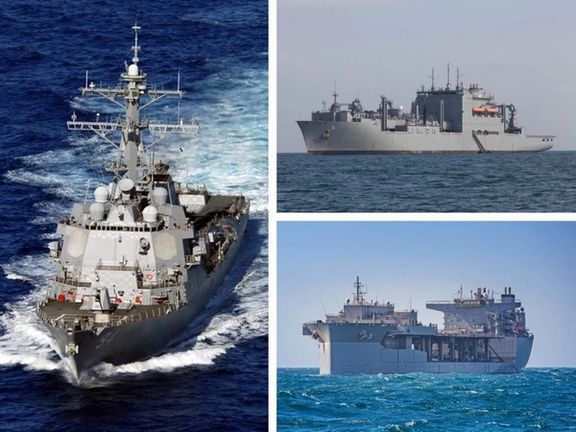Another Russian-Made Iranian Fighter Jet Bites The Dust

A Sukhoi-22 fighter jet belonging to Iran’s Revolutionary Guard crashed on Wednesday at an air base in the south-central city of Shiraz due to a “technical failure.”

A Sukhoi-22 fighter jet belonging to Iran’s Revolutionary Guard crashed on Wednesday at an air base in the south-central city of Shiraz due to a “technical failure.”
According to an IRGC statement, “A Sukhoi 22 aircraft belonging to the IRGC’s Aerospace Force had a technical failure while taking off at the Shiraz Air Base on Wednesday morning, and the pilots were forced to eject from the plane.”
IRGC-affiliated Fars news said both the pilot and co-pilot survived the incident thanks to their timely reaction.
Such incidents occur frequently in Iran as the country’s air force has an assortment of aging Russian warplanes, and US-made military aircraft bought before the 1979 revolution that are not considered to be in optimal condition as decades of Western sanctions have made it hard to maintain the aging fleet.
In June, a US-built F-14 Tomcat warplane crashed and exploded in Esfahan due to a technical fault in the engine but the two pilots survived. According to a survey by Flight Global in 2019, the Iranian air force operates around 24 F-14 Tomcats from a batch of 79 of the Grumman-made swing-wing jets. Those that still in service in Iran are maintained by improvisation, since the US sanctions prevent purchase of new equipment and parts.
In May, an F-7 fighter jet of the Iranian Air Force crashed near the same city while on a training mission, killing both of the aircraft’s pilots. In February, a fighter jet plunged into a soccer field in the country’s northwestern city of Tabriz, killing both pilots and a civilian.

A report by Iran’s Shargh newspaper says at least 200 people are still missing following the severe landslide and mudslide northwest of the capital Tehran last week.
The newspaper quoted locals as saying that the repugnant odor of the bodies which are buried under the mud has taken over the area around the Shiite shrine complex of Imamzadeh Davoud, one of the places worst hit by mud and floodwater. Some locals said they have seen many dismembered body parts.
Shargh claimed the locals had not been warned about the possibility of the flood beforehand, while Sahar Tajbakhsh, the head of the National Meteorological Organization, said in a TV program that the amount of precipitation was not anything new for the area, a valley that has experienced heavier rains with no such floods. She concluded that some construction or development projects must have changed the course of the water, causing the catastrophe.
According to official figures, as of Wednesday, 95 people are confirmed killed in the floods. More than 20 of Iran’s 31 provinces are affected by heavy rains and floods, with at least 20,000 homes destroyed.
Indian sub-continent summer monsoons usually bring some rain showers to Iran’s arid plateau, but every few decades the impact becomes more intense and causes flooding.
Partly due to the arid nature of the land and partly because of neglect in urban planning, even a modestly strong storm leads to deadly floods in Iran. Many dry riverbeds are choked off with construction or debris dumped by residents, leading to sudden flash floods in places no one expected.

The United States Tuesday asked permission to confiscate an Iranian plane impounded in Argentina on suspicions of links to international terrorist groups.
Argentina grounded the 747 cargo plane after its unannounced arrival from Mexico to an airport in Buenos Aires on June 8. The plane originally belonged to Iran’s Mahan airline affiliated with Iran’s Revolutionary Guard (IRGC) and sanctioned by the US for transporting arms to Syria and supporting terrorism.
The plane had arrived in Argentina with a crew of 19 people, including five Iranians, some with clear ties to the IRGC. Argentina confiscated their passports. In recent days, a judge ordered the release of 12 crew members after weeks of being denied permission to leave Argentina.
In June, Gerardo Milman, an Argentine lawmaker, told Iran International that Iranians aboard the Venezuelan plane planned “attacks on human targets.” Contrary to Iran’s claim June 13 that the plane was not owned by an Iranian company, Milman said the pilot was “a senior official of Qods (Quds) force,” Tehran’s extraterritorial intelligence and secret ops outfit listed as a terrorist organization by the United States.
Early in 2022, a Venezuelan government company decided to set up a cargo division that came to be called Emtrasur Cargo and its first plane was the Boeing 747-300M bought or leased from Mahan airlines and christened ‘Louisa Caceres Arismendi.’
The grounding of the 747 sparked weeks of intrigue as well as concern within the Argentine government over its ties to Iran and Venezuela and companies sanctioned by the US.

The confiscation request by the US Department of Justice followed the unsealing of a July 19 warrant for the plane's seizure in the US District Court for the District of Columbia, which alleged that the aircraft could be confiscated because it violated export control laws, the DOJ said.
The DOJ said the US-origin Boeing 747-300 aircraft is subject to sanctions as its sale from Iran's Mahan Air to Emtrasur last year, part of the Venezuelan Consortium of Aeronautical Industries and Air Services (Conviasa), violates U.S. export laws. Both companies are sanctioned by the United States for alleged collaboration with terrorist organizations.
"The Department of Justice will not tolerate transactions that violate our sanctions and export laws," said Assistant Attorney General Matthew Olsen of the DOJ's National Security Division in the statement.
The US move comes amid stalled talks to revive the 2915 Iran nuclear agreement, JCPOA. Apparently, after 16 months of indirect talks between Iran and the US, Tehran insists that the IRGC should be removed from the US list of Foreign Terrorist Organizations (FTO).
One intriguing part of the nearly two-month-long saga was the identity of the plane’s Iranian pilot. Shortly after the plane was impounded it became clear that the pilot was Gholamreza Ghasemi, a known IRGC Qods Force operative and reportedly a relative of Iran’s current interior minister Ahmad Vahidi. The other Iranians were also linked to IRGC or its terror-linked companies.
Mahan Air is sanctioned for ties to the Islamic Revolutionary Guard Corps-Quds Force (IRGC-QF), a US-designated terrorist organization. The US sanctioned Conviasa in 2019 for its ties to Venezuelan President Nicolas Maduro's government.
"The seizure of this aircraft demonstrates our determination to hold accountable those who seek to violate US sanctions and export control laws," said U.S. Attorney Matthew Graves.
Fourteen Venezuelans and five Iranians were traveling on the plane when it arrived in Buenos Aires. Seven of them are still detained in Argentina.
Argentina's Foreign Ministry did not immediately respond to a request for comment.
With reporting by Reuters

Security forces laid siege to a village in northern Iran Tuesday and started demolishing houses and farms belonging to members of the persecuted Baha’i faith.
Simin Fahandej, a spokeswoman for the Baha’i International Community, told Iran International Tuesday that over 200 security forces were deployed to block the roads leading to Roshankouh, a village in Mazandaran Province, and begin demolition of the houses and farms belonging to Bahai’s.
According to Fahandej, security forces arrested some Bahai’s who tried to stop the operations, confiscated mobile phones of some villagers to prevent them from recording videos and publishing them on social media, and warned locals not to take any photos or videos of their operations.
A video posted on social media by the Baha'i International Community Tuesday shows security forces using heavy construction machinery to demolish buildings in Roshankouh.
Since early June security forces and the judiciary of the Islamic have intensified pressure on the followers of the Baha’i faith, raiding over a dozen households, arresting tens including three of the former leaders of the community, and shutting down businesses.
The intelligence ministry claimed on Monday that the arrested Baha’is were linked to the Baha’i Universal House of Justice in Haifa, Israel, and had collected information in Iran and conveyed it to their headquarters. The Universal House of Justice is the nine-member supreme ruling body of the Bahaʼi Faith.
In 2021 fifty Baha’i homes were demolished in the small farming village of Ivel in the same province and the authorities confiscated the assets of 27 Baha’i families who had lived there for several generations claiming that money earned by Baha’is is “unlawfully earned”.
The Worldwide Baha’i Community said in a July 20 statement that Tehran had intensified its systematic campaign to suppress the religious minority in recent weeks, either arresting, summoning to court, putting on trial or closing the businesses of at least 20 Baha'i citizens just in July. Baha'i Religious Minority Says Iran Intensified Persecution Of Members.
Established by Bahaullah in the 19th century, the Baha’i faith initially spread in Iran and parts of the former Ottoman empire and remained mostly confined to Iran and the Ottoman empire until after the death of Bahaullah.
The Baha’i Faith traces its beginnings to the religion of Ali-Mohammad Shirazi, known as the Bab (the Gate), the founder of Babism who claimed to be a messenger of God in southern Iran in 1844. The Bab who said God would soon send a new prophet to mankind was executed for heresy against Islam which considers Muhammad as the last prophet of God.
In 1863 Bahaullah, the founder of Baha’i faith who was banished from Iran and settled in Iraq later, announced that he was the prophet promised by the Bab. The leadership of Baha’is fell to his son Abdul-Baha after his death in 1892 near Acre in present day Israel.
Baha’is believe in Muhammad as a prophet of God, and in the Quran as the Word of God while the Shia clergy consider Babism and the Baha’i faith as heretical sects. Accordingly, Iranian clergy and officials often refer to Baha’is as “followers of the heretical sect”
For nearly three centuries the followers of the Bab and then Bahaullah have been persecuted in Iran to varying degrees and subjected to mob attacks often instigated by the Shia clergy.
Supreme Leader Ali Khamenei has on several occasions called the Baha'i Faith a cult and in a religious fatwa in 2018 forbade contact, including business dealings, with followers of the faith.
Baha'is, who number around 300,000 in Iran, say their rights are systematically violated and they are often harassed, forced to leave their homes and businesses, and are deprived of government jobs and university education.

IAEA Director General Rafael Mariano Grossi says that “good words” from the Islamic Republic are not enough to satisfy international inspectors
Grossi expressed hope on Tuesday that Tehran is ready to be transparent about its nuclear program, which was “moving ahead very, very fast”.
When asked about the IAEA's role in monitoring any revival of Iran's 2015 nuclear deal with world powers under which it curbed its nuclear program in return for economic sanctions relief, he said Iran must grant IAEA inspectors access “commensurate to the size” of its uranium enrichment program if the agency is to credibly assure that it is peaceful.
“When it comes to nuclear, good words will not do it. What you need to do is to be transparent and compliant and work with us. We are ready and I hope they will be as well,” Grossi told reporters at the United Nations.
“They have a very ambitious nuclear program that needs to be verified in the appropriate way. The program is moving ahead very, very fast and not only ahead, but sideways as well, because it's growing in ambition and in capacity.”
Iran's nuclear chief Mohammad Eslami told reporters in Tehran on Mondaythat Iran is technically capable of building a nuclear bomb; a statement that has been made before by at least two other Iranian officials and has been generally taken as a defiant signal from Tehran. President Ebrahim Raisi also reiterated last week that the people of Iran have told him they want to resist rather than sign an agreement with the United States.

The Israeli and the US navies have started a four-day joint military war game in the Red Sea as Jerusalem’s worries are growing about Iran’s presence in the region.
“The exercise is a bilateral training event between US 5th Fleet and Israeli naval forces that focuses on mission planning, maritime interdiction and other drills at sea,” the US fleet said on Monday, about a month after Defense Minister Benny Gantz warned that Tehran’s maritime activity in the area was the “most significant” in a decade.
The USS Nitze – a small destroyer with a crew of about 400 with cruise missiles for long-range land attacks and torpedoes -- the USS Lewis B Puller military cargo ship, and the USNS Matthew Perry logistical support ship are involved in the exercise.
The Israeli warships involved in the drill, the Saar 5 Class Corvette INS Eilat and the Sa’ar 4.5 Class Missile Ship INS Keshet, would “participate in a variety of missions alongside [US 5th Fleet] ships and a refueling tanker,” read a statement by the Israel Defense Forces.
Israel has held several naval exercises with the 5th Fleet since last November in the Red Sea, some alongside the UAE and Bahrain.
The US 5th Fleet -- headquartered in Manama, Bahrain -- includes maritime forces operating in the Persian Gulf, Gulf of Oman, Red Sea, parts of the Indian Ocean and three critical choke points at the Strait of Hormuz, Suez Canal and Bab al-Mandeb.
In July, Iran-backed Houthis of Yemen said Sana’a will not allow the Red Sea to become an “Israeli lake.”